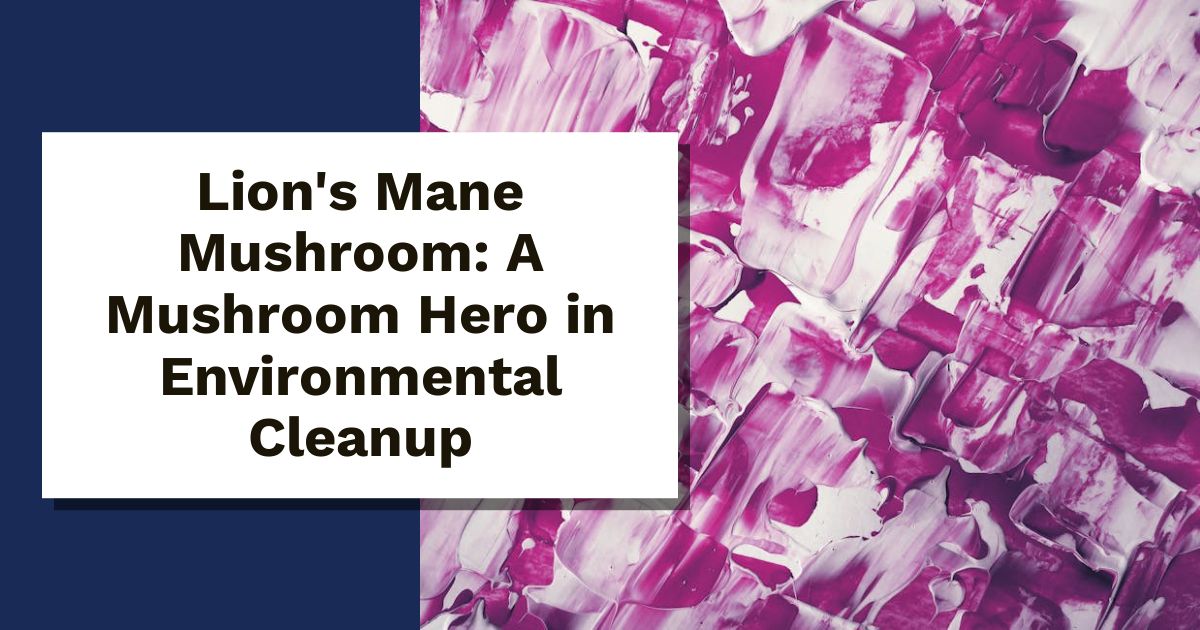Picture this: a fluffy white mushroom, resembling a lion’s mane, hiding a secret power. Lion’s Mane mushroom isn’t just a tasty treat; it’s also a champion for our planet. With its impressive ability to break down harmful pollutants, this fascinating fungus plays a crucial role in mycoremediation—the process of using mushrooms to cleanse the environment.
In this post, we’ll uncover how Lion’s Mane works its magic to tackle pollution. You’ll learn about its unique properties, practical applications, and how it fits into the bigger picture of ecological health. Whether you’re a mushroom enthusiast or just curious about eco-friendly solutions, there’s something here for you. Let’s dive into the world of Lion’s Mane and discover how it’s helping clean up our planet, one spore at a time!
What is Mycoremediation?
Mycoremediation is quite the fascinating process. It harnesses the power of fungi, particularly mushrooms, to clean up contaminated environments. Using fungi to break down harmful pollutants is an innovative way to restore ecosystems. By deploying these little wonders, we can effectively tackle issues like soil and water pollution without relying on harsh chemicals.
Defining Mycoremediation
Mycoremediation involves using fungi to degrade or isolate environmental contaminants. Unlike traditional methods that often employ bacteria, this approach focuses on the unique abilities of mushrooms. They produce specific enzymes and metabolites that can break down pollutants like heavy metals, pesticides, and even petroleum products. Think of it like a natural sponge soaking up toxins while simultaneously breaking them down into harmless substances. This process has gained traction as an eco-friendly solution to environmental degradation. For a deeper dive into the concept, check out this definition of Mycoremediation.
Why It Matters
The significance of mycoremediation cannot be overstated. Our planet faces a growing pollution crisis, affecting air, soil, and water quality. Here are a few reasons why mycoremediation is crucial:
- Cost-effective: Utilizing fungi is often cheaper than traditional cleanup methods. It reduces the need for expensive machinery and toxic chemicals.
- Eco-friendly: This method is sustainable and aligns with efforts to protect the environment. It promotes biodiversity rather than harming it.
- Effective: Studies show that mycoremediation can significantly reduce pollutants, restoring contaminated sites.
Fungi are nature’s recyclers, and their role in mycoremediation is essential for cleaning up our planet. To explore its benefits further, visit The Benefits of Mycoremediation.
Lion’s Mane Mushroom Overview
Lion’s Mane mushroom, scientifically known as Hericium erinaceus, is a unique fungus that has captured the attention of health enthusiasts and environmentalists alike. Its striking appearance resembles a fluffy white mane, making it both visually appealing and a topic of fascination. Beyond just looks, this mushroom carries a treasure trove of benefits that contribute to both personal health and ecological wellness.
Physical Characteristics
At first glance, Lion’s Mane mushroom stands out in the fungi world. The mushroom boasts long, cascading spines that give it a luscious, mane-like appearance. These spines can be white or yellowish, adding to its charm. A mature Lion’s Mane can grow up to 12 inches in diameter, making it a considerable presence on the forest floor.
The texture is soft and velvety, resembling the surface of a lion’s mane—hence the name. Its unique shape often leads many to mistake it for a bizarre sea creature rather than a mushroom. When harvested, it has a pleasant, delicate aroma. Cooked Lion’s Mane has a mild flavor, often compared to seafood, particularly lobster. This delightful taste, combined with its distinct look, makes it an enticing addition to any dish. For an introduction to its characteristics, check out this Lion’s Mane Mushroom Overview.
Nutritional and Medicinal Benefits
Lion’s Mane mushroom isn’t just a pretty face; it offers numerous health benefits. Packed with antioxidants, vitamins, and minerals, it provides a nutritional boost. Some of its standout benefits include:
- Cognitive Support: Research suggests that Lion’s Mane may help enhance memory and cognitive functions. It promotes nerve growth factor (NGF) production, which is essential for brain health. This is especially promising for those looking to improve their mental sharpness or fend off cognitive decline.
- Stress and Anxiety Reduction: Studies indicate that this mushroom may help alleviate symptoms of anxiety and depression. With its calming properties, it serves as a natural remedy for those seeking alternative mental wellness solutions.
- Anti-Inflammatory Properties: Lion’s Mane is noted for its ability to reduce inflammation in the body. By combating oxidative stress, it may protect against chronic diseases and promote overall health.
- Digestive Health: It also supports gut health by encouraging the growth of beneficial gut bacteria. A healthy gut contributes to better digestion and overall well-being.
The mushroom’s role in mycoremediation adds another layer to its importance. Its capacity to break down toxic compounds in the environment aligns with its health benefits. By using Lion’s Mane mushrooms in environmental cleanup efforts, we tap into a dual purpose: supporting human health while fostering ecological restoration. To learn more about these health benefits, visit What Are the Health Benefits of Lion’s Mane Mushrooms?.
Lion’s Mane and Mycoremediation
Lion’s Mane mushroom isn’t just good for your brain; it’s also a powerful player in cleaning up our environment. This remarkable fungus has a knack for breaking down pollutants, making it a star in the field of mycoremediation. Let’s break it down!
Breaking Down Pollutants
Lion’s Mane mushrooms help decompose harmful substances thanks to their amazing enzymes. These tiny powerhouses produce compounds that can break down toxic materials into harmless byproducts. Think of it as nature’s cleanup crew—swooping in to tackle pollution like a sponge soaking up a spill.
This mushroom can target a variety of pollutants, including:
- Heavy Metals: Lion’s Mane can absorb and render heavy metals less toxic. This is vital in areas contaminated with industrial waste.
- Pesticides: It effectively breaks down pesticides, converting them into nontoxic compounds.
- Oil and Hydrocarbons: Research shows that it can degrade petroleum products, helping to clean oil spills.
By using Lion’s Mane, we tap into a natural method to detoxify our soils and waters. For a closer look at fungi’s role in remediation, visit this Mushroom as a product and their role in mycoremediation.
Case Studies
A few recent case studies showcase the success of Lion’s Mane in mycoremediation. Here are some striking examples:
- Toxic Metal Removal: In a study, Lion’s Mane was used to remove toxic metals from soil. After treatment, researchers found over 95% reduction in contaminants, bringing life back to dead soils. To read the full details, check out this article on Using Mushrooms for Environmental Cleanup: Inspiring Success Stories.
- Oil Spill Clean-Up: Another project involved Lion’s Mane in an oil-contaminated area. The mushroom significantly reduced oil levels, making the soil safe for plant growth again. Find out more about this study at Harnessing the Power of Mushrooms to Clean Up Our Soil.
- Plastic Pollution: There have also been experiments using Lion’s Mane to break down plastic waste. Researchers discovered it can convert plastics into biodegradable components, showing promise in tackling the plastic crisis. Explore more about this topic in the article Mushrooms Clean Up Plastic. Why Aren’t They Used More?.
How It Compares to Other Fungi
When we talk about mycoremediation, Lion’s Mane isn’t alone. Other mushrooms, like Pleurotus (oyster mushrooms), also do great work in cleaning up contaminated environments. Here’s how they stack up against Lion’s Mane:
- Heavy Metal Absorption: Research suggests that while Lion’s Mane is good, some strains of Pleurotus are even better at absorbing heavy metals and can outperform Lion’s Mane in specific conditions. To learn more about this comparison, check out the study Growth response and mycoremediation of heavy metals by mushrooms.
- Speed of Breakdown: Pleurotus can break down organic contaminants faster than Lion’s Mane. Its rapid growth and fruiting cycles provide quicker results in cleanup efforts.
- Versatility: Lion’s Mane shines in areas requiring cognitive and nerve growth support in humans. However, in terms of sheer pollutant breakdown, other fungi may offer broader capabilities.
This comparison shows that while Lion’s Mane is impressive, it’s part of a larger community of fungi working together for environmental health. To dive deeper into the specifics, visit A comparison between the different myco-remediation mechanisms.
Lion’s Mane encompasses both environmental benefits and unique health properties, making it a true multifunctional marvel of nature!
How to Use Lion’s Mane for Mycoremediation
Lion’s Mane mushroom isn’t just delicious; it’s also a superhero in environmental cleanup! This section will guide you through cultivating Lion’s Mane and how to use it effectively in contaminated areas.
Cultivating Lion’s Mane
Growing Lion’s Mane mushrooms can be an exciting adventure. Here’s how you can get started:
- Choose Your Substrate: Lion’s Mane loves hardwoods. The ideal mix consists of hardwood pellets and soy hulls. You can find detailed instructions on preparing these in this guide.
- Sterilization: Before inoculating your substrate, sterilize it to remove unwanted microbes. You can steam or use a pressure cooker for this task.
- Inoculation: Once sterilized, mix in your Lion’s Mane spawn. This is crucial as the spores or mycelium will colonize the substrate.
- Environmental Conditions: Ensure high humidity and good air circulation. Lion’s Mane needs about 85% humidity to thrive. Keep the temperature around 60-75°F.
- Patience is Key: It takes about 2-3 weeks for the mycelium to colonize the substrate fully. Look for white, fuzzy growth!
- Fruiting: Once fully colonized, introduce fresh air and lower humidity to encourage fruiting. Cut an “X” into the substrate bag to stimulate growth. Check out this Lion’s Mane mushroom kit for more tips.
Applying in the Environment
Getting Lion’s Mane mushrooms into contaminated areas is where the real fun starts! Here’s how to do it:
- Identify Contaminated Sites: Look for areas with pollutants like heavy metals, pesticides, or oil spills.
- Prepare the Site: Clear away debris to expose the contaminated soil. You want the Lion’s Mane to make direct contact with the pollutants.
- Introduce Lion’s Mane: Plant the colonized substrate directly into the contaminated soil. Or, if you have bulk mushroom spawn, you can spread it across the area where it’s needed.
- Monitor Conditions: After introduction, keep an eye on the moisture levels and temperature. Ideally, the area should remain moist but not waterlogged.
- Observe and Wait: It takes time for the mushrooms to do their magic. Be patient! Watch how they grow and how the affected environment starts to shift. For example, Lion’s Mane can degrade pollutants like heavy metals and pesticides effectively.
- Follow-Up: Once mushrooms fruit, collect and analyze to check their detoxifying effectiveness. Research suggests that Lion’s Mane can significantly impact cleaning polluted environments. For more insights on environmental applications, check out this link on Lion’s Mane in remediation efforts.
With a little cultivation savvy and environmental care, you can harness Lion’s Mane mushroom for a cleaner, greener future!
Future of Mycoremediation with Lion’s Mane
As we look ahead, the potential of Lion’s Mane mushroom in mycoremediation seems brighter than ever. Ongoing research is unearthing its remarkable capabilities, unlocking new possibilities for environmental restoration.
Research Innovations
Numerous studies are currently exploring the interaction between Lion’s Mane and environmental pollutants. Researchers are focusing on how this unique fungus can tackle a variety of contaminants, paving the way for innovative mycoremediation techniques. Some noteworthy findings include:
- Enhanced Degradation of Pollutants: Recent studies show that Lion’s Mane can effectively break down pesticides and hydrocarbons. Researchers are examining its enzyme production and metabolic processes that contribute to this ability. You can find more about this topic in the Mycoremediation brings the fungi to waste disposal and ecosystem restoration article.
- Biosorption Techniques: Scientists are investigating the biosorption capabilities of Lion’s Mane, where the mushroom’s mycelium absorbs heavy metals from contaminated soil. This could offer a new, eco-friendly method for cleaning up industrial sites. For a detailed look, check out the findings in Mushroom as a product and their role in mycoremediation.
- Commercial Applications: There’s increasing interest in scaling up production for commercial use. Researchers are looking into using waste materials as substrates for Lion’s Mane cultivation, making the process more sustainable and economical. This approach was recently discussed in a study on Commercial scale production of Yamabushitake mushroom.
Environmental Impact
The long-term benefits of using Lion’s Mane in environmental cleanup are intriguing. By employing this mushroom for mycoremediation, we could see significant positive shifts in our ecosystems:
- Soil Restoration: As Lion’s Mane breaks down pollutants, it helps restore soil health. Healthier soil supports plant growth, which in turn fosters biodiversity. This can lead to more robust ecosystems, creating a thriving environment for various species.
- Water Quality Improvement: Using Lion’s Mane in contaminated water bodies could purify the water, making it safe for aquatic life. Cleaner water means healthier ecosystems, benefiting both wildlife and human populations.
- Carbon Sequestration: As Lion’s Mane promotes healthy plant life through soil restoration, it contributes to carbon sequestration. This could help combat climate change by absorbing carbon dioxide from the atmosphere.
- Community Engagement in Cleanup Projects: Incorporating Lion’s Mane into community-led cleanup initiatives makes the process more accessible and engaging. People can participate in growing and deploying the mushroom, creating a sense of stewardship over their environment. To explore more about the potential benefits, visit 9 Health Benefits of Lion’s Mane Mushroom.
Lion’s Mane holds promise—not just as a source of nutrition and wellness, but as a key player in repairing our planet. With continued research and application, it could revolutionize how we approach pollution and environmental degradation, taking us one step closer to a cleaner, healthier world.
Conclusion
Lion’s Mane mushroom is a fantastic ally in the fight against pollution. Its ability to break down harmful substances, from heavy metals to pesticides, makes it a powerful tool for mycoremediation.
By integrating Lion’s Mane into environmental cleanup efforts, we’re not just improving our ecosystems; we’re also tapping into nature’s own solutions.
Consider the many ways this mushroom can help both your health and the planet. Ready to see how Lion’s Mane could transform your space and support a cleaner Earth? The possibilities are endless!
Dr. Cordy is a passionate advocate for the incredible benefits of Lion's Mane mushrooms, blending scientific insight with a deep enthusiasm for natural wellness. When he’s not exploring the latest research on functional fungi, you’ll find him chasing waves as an avid surfer, strategizing over chess matches, or embarking on outdoor adventures that fuel his curiosity and love for nature. A devoted dog dad and lifelong explorer, Dr. Cordy combines his diverse passions with a mission to educate and inspire others about the transformative potential of Lion’s Mane mushrooms. You can unearth his latest Lion's Mane insights here. 🍄


